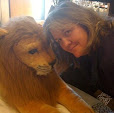Author Tracy Chevalier not only never repeats herself when it comes to her historical novels, diving into drastically different time periods, locations, and characters with each novel, all that require extensive research, but with her latest, The Glassmaker, she shows a courageous, creative willingness to play with the time/space continuum.
Overwhelmingly, I prefer realism over fantasy in fiction, with just a few magical realism exceptions, so at first I struggled with what Chevalier was doing in The Glassmaker, but the end result was a triumph.
So, what does she do? The Glassmaker tells the story of Orsola Rosso, daughter of a maestro glassmaker in Murano (one of the Venetian islands) in the 1480s. Her family have been glassmakers for generations, with the craft being passed from father to son in a tightly controlled industry. We learn about Orsola's family--her brothers, her savvy mother, her baby sister, and how the family handles the untimely death of her father, who dies during a glassmaking accident.
We learn how the glass works produced by the Rosso family are sold throughout Europe, through a German middleman, Klingenberg, who resides in Venice. Orsola becomes a glass bead maker herself, one of just a few females who learn to work with glass. We learn that a handsome stranger is hired on to the Rosso workshop and Orsola cannot stop looking at him.
And then the timeframe of the story shifts from the late 15th century to roughly 100 years later, to the 1570s. Orsola is now a young woman, in love with Antonio, still handsome but no longer a stranger, but not appropriate for the daughter of a glass maestro to marry.
Plague descends upon Venice and Murano. Orsola and most of her family survive not only the disease but the quarantines enforced on them when members of their household fall ill. Life is difficult, but the family survives and Orsola becomes a skilled bead maker and entrepreneur.
Throughout the rest of the novel, as Orsola ages from a young woman to a wife and mother, then on to middle age and beyond, the time period in which the story is set shifts as well, sometimes by a 100 or so years, sometimes more, taking us from the time when Venice was a trading capital of the world through the time of Casanova and the growth of casinos and Carnival, then the French invasion of Venice and the dissolution of the Republic, then into the wars of the 20th century, and finally to 2020 and Covid.
The Rosso family and Orsola evolve as families do, with births and deaths, marriages and intrigues, jealousies and reconciliations. Their basic family history remains intact--they are a glass-making family, their father died in an accident, they live and work on Murano and visit Venice for business more than pleasure. I found it fascinating that Chevalier was able to tell the story of this family intact as she skipped from timeframe to timeframe, which gets to the heart of why I love stories. The setting is the window dressing, it adds flavor and interest, but the stories of people and how they love, grow, and dream are timeless.
I also think this was a super cool way to tell the history of Venice and glass-making as an industry. I loved hearing about how glass works are made, distributed, sold, and treasured. And, I loved seeing how she handled social changes over time (e.g., a character who was a slave in the 15th century is not a slave in the 20th, but he is still restricted by how others perceive him).
I do think Chevalier was both creative and courageous in how she chose to tell the story of Orsola and her family against the backdrop of the history of Venice, Murano, and the glass-making industry. It took tremendous skill as an author to present both stories in a realistic way. Bravo!
Now I am ready to return to Venice, and this time, I will go to Murano!


This sounds like a detailed history of not just a family, but of the trade and city.
ReplyDeleteMost definitely--I found the history of glass making within the context of the history of Venice as interesting as the characters of the story.
DeleteI admire the way every book is so different! I haven't read this one yet but I am looking forward to it at some point.
ReplyDeleteI still have some of her backlist to read, but I mostly read her new books as they come out.
DeleteThat is an interesting way to tell a story, separating out Orsola's personal timeline from the historical timeline like that. It speaks volumes about what a good writer Chevalier is to pull it off so well.
ReplyDeleteI was just in awe of Chevalier the whole time I was reading this. A master at work.
DeleteIt sounds like Orsolo and her family don't age and so we get to experience glassmaking and Venice from the 1470' up to today. That's a good way to tell a story. I would like to read Chevalier's book Remarkable Creatures about the paleontologist Mary Anning.
ReplyDeleteI love Remarkable Creatures! I've read it twice--so good. I know there's a third read in my future.
DeleteBTW, Orsola and her family do age, but much more slowly than time passes. She starts out as a young girl and ends up in her late 60's in the 2020's.
DeleteThanks and I must Read Remarkable Creatures. I saw the movie which I liked. And for me the standout in the movie was the performance by the actress who played Mary Anning's mother. That performance so moving, brought me to tears.
DeleteGreat blog
ReplyDeleteThe Venice setting sounds really good. I last read her novel A Single Thread which was pretty interesting, but I need to go back and read Remarkable Creatures, which calls to me most. Her books are all quite different and good historical fiction.
ReplyDeleteRemarkable Creatures is one of her best, for sure!
Delete